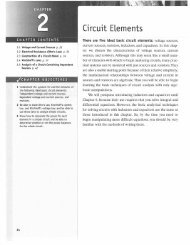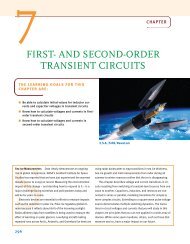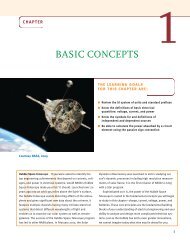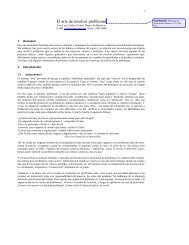chapter 1
chapter 1
chapter 1
- No tags were found...
Create successful ePaper yourself
Turn your PDF publications into a flip-book with our unique Google optimized e-Paper software.
1.5 Practical Two-Terminal Elements CHAPTER ONE 17if a battery delivers one watt for an hour, then we say that it has supplied onewatt-hour (3600 joules) of energy.Assuming that the battery terminal voltage is constant at V, because thepower delivered by the battery is the product of the voltage and the current,an equivalent indication of the power delivered is the amount of current beingsupplied. Similarly, the product of current and the length of time the batterywill sustain that current is an indication of the energy capacity of thebattery. A car battery, for instance, might be rated at 12 V and 50 A-hours.This means that the battery can provide a 1-A current for 50 hours, or a 100-Acurrent for 30 minutes. The amount of energy stored in such a battery isEnergy = 12 × 50 = 600 watt-hours = 600 × 3600 = 2.16 × 10 6 joules.example 1.1 a lithium-ion battery A Lithium-Ion (Li-Ion)battery pack for a camcorder is rated as 7.2 V and 5 W-hours. What are its equivalentratings in mA-hours and joules?Since a joule( J) is equivalent to a W-second, 5 W-hours is the same as 5 × 3600 =18000 J.Since the battery has a voltage of 7.2 V, the battery rating in ampere-hours is 5/7.2 =0.69. Equivalently, its rating in mA-hours is 690.example 1.2 energy comparison Does a Nickel-Cadmium(Ni-Cad) battery pack rated at 6 V and 950 mA-hours store more or less energy thana Li-Ion battery pack rated at 7.2 V and 900 mA-hours?We can directly compare the two by converting their respective energies into joules. TheNi-Cad battery pack stores 6 × 950 × 3600/1000 = 20520 J, while the Li-Ion batterypack stores 7.2 × 900 × 3600/1000 = 23328 J. Thus the Li-Ion battery pack storesmore energy.When a battery is connected across a resistor, as illustrated in Figure 1.4,we saw that the battery delivers energy at some rate. The power was the rateof delivery of energy. Where does this energy go? Energy is dissipated bythe resistor, through heat, and sometimes even light and sound if the resistoroverheats and explodes! We will discuss resistors and power dissipation inSection 1.5.2.If one wishes to increase the current capacity of a battery without increasingthe voltage at the terminals, individual cells can be connected in parallel,as shown in Figure 1.11. It is important that cells to be connected in parallelbe nearly identical in voltage to prevent one cell from destroying another.For example, a 2-V lead-acid cell connected in parallel with a 1.5 V flashlightcell will surely destroy the flashlight cell by driving a huge current through it.+ +V V- -(a)(b)V+1.5 V-FIGURE 1.11 Cells in parallel.+-













